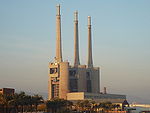Energy in Montecara
Electricity
| Data | |
|---|---|
| Electricity coverage | 100% |
| Continuity of supply | 99.99% |
| Installed capacity (2017) | 4795 MW |
| Share of fossil energy | 92.28% |
| Share of renewable energy | 7.72% |
| Average electricity use (2017) | 8,194 kW·h per capita |
| Services | |
| Share of private sector in generation | 100% |
| Competitive supply to large users | No |
| Competitive supply to residential users | No |
| Institutions | |
| Responsibility for transmission | Comega |
Montecara consumes about 14.35 billion kW·h of electricity per year.
Montecara is in the process of moving away from fossil fuels and toward sustainable energy but badly lags behind schedule in its goal, set in 2000, to achieve 100% renewable electricity by 2025. Less than ten percent of the electricity generated in Montecara comes from a renewable source, with the remaining more than ninety percent coming from oil and natural gas. There are several obstacles to increased use of renewables: limited land area means that there is little free space to deploy solar panels, the terrain is not generally favorable to onshore wind power, and high land values mean that land-intensive renewable plants are prohibitively expensive to build and maintain.
Nuclear power is a highly contentious political issue in Montecara. Montecara has been a nuclear-free zone since 1985 in response to plans by Comega to build a boiling water reactor.
Montecara must import all its fossil fuels and is therefore highly dependent on the flow of international shipping to supply its energy needs. Tanker ships arrive several times per week with supplies of oil and liquefied natural gas, and the state estimates that if its sea lanes were disrupted, fuel and power shortages would likely develop within less than 48 hours.
An interconnector cable allows electricity to be exported to and imported from mainland Euclea as needed.
Power plants
| Name | Image | Type | Capacity (MW) | Commissioned |
|---|---|---|---|---|
| Nùvol power plant | Natural gas (primary) Oil (secondary) |
1050 (3 × 350) | 1982 | |
| Siròco Nòvo array | Offshore wind | 309 | 2013 | |
| Cocàl regeneration plant | Waste-to-energy | 85 | 1999 |
Sources
Twin oil and natural gas pipelines run from Tsabara to Florena underneath Montecara. These are tapped off for use in Montecaran power plants and for use in transportation. These pipelines provide the vast majority of oil and gas resources used locally, but some oil and liquefied natural gas arrives by ship as well.
Regulation
The Secretary of the Environment, Transport, and Urban Development has authority over energy regulation in Montecara.
Taxation
Transportation
VM is in the process of converting its entire bus fleet away from fossil fuel. It began to replace aging diesel buses with compressed natural gas vehicles in the late 1990s and is now replacing old equipment with all-electric models.
The state charges higher registration fees to vehicles with poor fuel efficiency.
Diesel fuel sold in Montecara must have a minimum cetane number of 53 and a maximum sulfur content of 10 ppm. This includes the fuel oil burned in Montecara's power plants.
Shipping
Bunker C fuel is banned from use in Montecaran waters. Additionally, all marine fuel must have a maximum sulfur content of 0.1%. This essentially limits marine fuel options to Bunker A or lighter.


